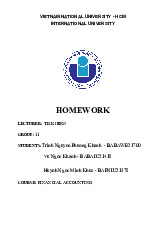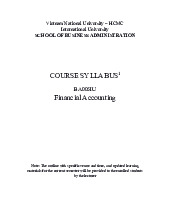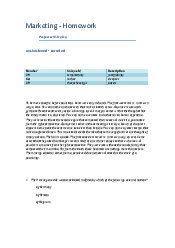






Preview text:
2/15/2020 Exchange Rate Determination C H A P T E R 4 1
1. Explain how exchange rate movements are measured.
2. Explain how the equilibrium exchange rate is determined. Chapter r
3. Examine factors that determine the equilibrium exchange rate. Objectives
4. Explain the movement in cross exchange rates.
5. Explain how financial institutions attempt
to capitalize on anticipated exchange rate movements. 2 1 2/15/2020 Measuring Exch c ange Rate Movemen e ts
Depreciation: decline in a currency’s value
Appreciation: increase in a currency’s value
Comparing foreign currency spot rates over two points in time, S and St-1 S − St−1 Percent i n f oreign c urrency a v lu e = St 1−
A positive percent change indicates that the currency has . appreciated A
negative percent change indicates that it has depreciated. 3 Exhibit 4.1 How Exchange Rate
Movements and Volatility Are Measured 4 2 2/15/2020
✓The exchange rate represents the price of a currency, or
the rate at which one currency can be exchanged for another.
✓Demand for a currency increases when the value of the
currency decreases, leading to a downward sloping E
demand schedule. (See Exhibit 4.2) Exchange Rate
✓Supply of a currency increases when the value of the Equiliibrium
currency increases, leading to an upward sloping supply schedule. (See Exhibit 4.3)
✓Equilibrium equates the quantity of pounds demanded
with the supply of pounds for sale. (See Exhibit 4.4)
✓In liquid spot markets, exchange rates are not highly
sensitive to large currency transactions. 5
Factors Influence Exchange Rates
e = f (INF , INT , INC, GC, EXP) where e = p ercentage c hange i n the s pot r ate INF = change i n th e different a i l b etween U S . . i nflation a n d the f oreign c ountry' i s nflation INT = change i n th e different a i l b etween th e U.S. i nterest r ate a n d the f oreign c ountry' i s nterest r ate INC = c hange i n the d ifferent a i l b etween t e h U.S. i ncome l eve l an d the f oreign c ountry' i s ncome l evel GC =c hange i n g overnment c ontrols EXP = c hange i n e xpectati n o s o f f uture e xchange r ates 6 3 2/15/2020 Factors Infl f uence Exch c ange Rates
Relative Inflation: Increase in U.S. inflation leads to increase in U.S. demand for
foreign goods, an increase in U.S. demand for foreign currency, and an increase in
the exchange rate for the foreign currency. (See Exhibit 4.5)
Relative Interest Rates: Increase in U.S. rates leads to increase in demand for U.S.
deposits and a decrease in demand for foreign deposits, leading to a increase in
demand for dollars and an increased exchange rate for the dollar. (See Exhibit 4.6) Fisher Effect: Real i nterest rat e Nominal i nterest r at e − I nflation r ate 7 Factors Infl f uence Exch c ange Rates (cont.)
Relative Income Levels: Increase in U.S. income leads to increased in
U.S. demand for foreign goods and increased demand for foreign
currency relative to the dollar and an increase in the exchange rate
for the foreign currency. (See Exhibit 4.7) Government Controls via:
◦ Imposing foreign exchange barriers
◦ Imposing foreign trade barriers
◦ Intervening in foreign exchange markets
◦ Affecting macro variables such as inflation, interest rates, and income levels. 8 4 2/15/2020 Factors s Influ l ence Exch c ange Rates e (c ( on o t.)
Expectations: If investors expect interest rates in one country
to rise, they may invest in that country leading to a rise in
the demand for foreign currency and an increase in the
exchange rate for foreign currency.
▪Impact of signals on currency speculation. Speculators may
overreact to signals causing currency to be temporarily overvalued or undervalued. 9
Factors Influence Exchange Rates (cont.)
Interaction of Factors: some factors place upward pressure
while other factors place downward pressure. (See Exhibit 4.8)
Influence of Factors across Multiple Currency Markets:
common for European currencies to move in the same direction against the dollar. 10 5 2/15/2020
Exhibit 4.8 Summary of How Factors Can Affect Exchange Rates 11 Movements in i Cr C os o s Ex E ch c ange Rates e
If currencies A and B move in same direction, there is no change in the cross exchange rate.
When currency A appreciates against the dollar by a greater (smaller) degree
than currency B, then currency A appreciates (depreciates) against B.
When currency A appreciates (depreciates) against the dollar, while currency B is
unchanged against the dollar, currency A appreciates (depreciates) against
currency B by the same degree as it appreciates (depreciates) against the dollar. 12 6 2/15/2020 An A ti t cip i ati t on of f Ex E ch c an a ge Ra R te Mo M vem e ents
Institutional speculation based on expected appreciation - When financial institutions
believe that a currency is valued lower than it should be in the foreign exchange
market, they may invest in that currency before it appreciates.
Institutional speculation based on expected depreciation - If financial institutions
believe that a currency is valued higher than it should be in the foreign exchange
market, they may borrow funds in that currency and convert it to their local currency
now before the currency’s value declines to its proper level.
Speculation by individuals – Individuals can speculate in foreign currencies.
The “Carry Trade” – Where investors attempt to capitalize on the differential in
interest rates between two countries. 13 Summary
Exchange rate movements are commonly measured by the percentage change in their values over a
specified period, such as a month or a year.
The equilibrium exchange rate between two currencies at any point in time is based on the demand
and supply conditions. Changes in the demand for a currency or the supply of a currency for sale will
affect the equilibrium exchange rate.
The key economic factors that can influence exchange rate movements through their effects on
demand and supply conditions are relative inflation rates, interest rates, and income levels, as well as government controls.
Unique international trade and financial flows between every pair of countries dictate the unique
supply and demand conditions for the currencies of the two countries, which affect the equilibrium
cross exchange rate. The movement in the exchange rate between two non-dollar currencies can be
determined by considering the movement in each currency against the dollar and applying intuition. 14 7




